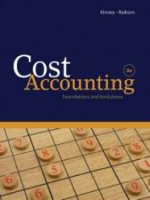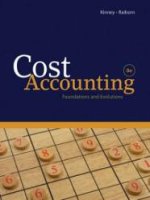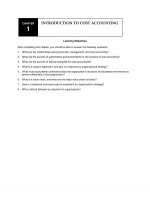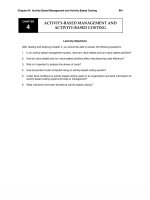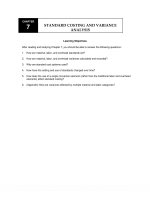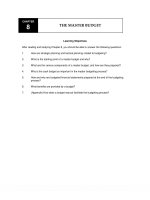Solution manual cost accounting 8th by kinney chapter 08
Bạn đang xem bản rút gọn của tài liệu. Xem và tải ngay bản đầy đủ của tài liệu tại đây (323.18 KB, 16 trang )
To download more slides, ebook, solutions and test bank, visit
CHAPTER
8
THE MASTER BUDGET
Learning Objectives
After reading and studying Chapter 8, you should be able to answer the following questions:
1.
How are strategic planning and tactical planning related to budgeting?
2.
What is the starting point of a master budget and why?
3.
What are the various components of a master budget, and how are they prepared?
4.
Why is the cash budget so important in the master budgeting process?
5.
How and why are budgeted financial statements prepared at the end of the budgeting
process?
6.
What benefits are provided by a budget?
7.
(Appendix) How does a budget manual facilitate the budgeting process?
©2011 Cengage Learning. All Rights Reserved. SM Cost Accounting 8th Edition by Raiborn and Kinney.
Visit to download more slides, ebooks, solution manual, and test bank.
To download more slides, ebook, solutions and test bank, visit
Chapter 08: The Master Budget
IM 2
Terminology
Budget: a financial plan for the future based on a single level of activity; the quantitative expression of a
company’s commitment to planned activities and resource acquisition and use
Budgeting: the process of formalizing plans and translating qualitative narratives into a documented
quantitative format
Budget manual: a detailed set of documents that provides information and guidelines about the
budgetary process
Budget slack: an intentional underestimation of revenues and/or overestimation of expenses in a
budgeting process
Continuous budget: an on-going 12-month budget maintained by successively adding a new budget
month (12 months into the future) as each current month expires
Financial budget: a plan that combines the monetary details from the operating budgets; includes the
cash and capital budgets of a company as well as the pro forma financial statements
Imposed budget: a budget developed by top management with little or no input from operating
personnel; operating personnel are then informed of the budget goals and constraints
Master budget: the comprehensive set of budgets, budgetary schedules, and pro forma organizational
financial statements
Operating budget: a budget expressed in both units and dollars; includes components of the various pro
forma financial statements such as a sales budget, production budget, purchases budget, direct labor
budget, overhead budget, and selling and administrative budget
Participatory budget: a budget that has been developed through a process of joint decision making by
top management and operating personnel
Rolling budget: (see continuous budget)
Strategic planning: top-level management planning on a long-range basis (5 to 10 years) that produces
a statement of long-range organizational goals and the strategies and policies that will help achieve those
goals
Tactical planning: Short-term planning (1 – 18 months) that determines how the organization’s strategic
plans will be achieved
©2011 Cengage Learning. All Rights Reserved. SM Cost Accounting 8th Edition by Raiborn and Kinney.
Visit to download more slides, ebooks, solution manual, and test bank.
To download more slides, ebook, solutions and test bank, visit
Chapter 08: The Master Budget
IM 3
Lecture Outline
LO.1: How are strategic planning and tactical planning related to budgeting?
A. Introduction
1. Planning is the cornerstone of effective management and in complex situations successful
planning requires that managers predict, with reasonable precision, the key variables that affect
company performance.
a. A goal without a plan is just a wish.
2. This chapter covers the budgeting process and preparation of the master budget.
B. The Budgeting Process
1. Budgeting is the process of formalizing plans and translating qualitative narratives into a
documented, quantitative format.
a. A budget is the quantitative expression of a company’s commitment to planned activities and
resource acquisition and use.
b. A budget is a type of standard that allows variances to be computed and feedback about
those variances to be given to the appropriate managers.
c.
Budgets can be viewed from a long-term (strategic) or short-term (tactical) perspective.
2. Strategic Planning
a. Strategic planning is the process of developing a statement of long-range (5–10 years)
goals for the organization and defining the strategies and policies that will help the
organization achieve those goals.
b. Key variables that are believed to be the direct causes of the achievement or
nonachievement of organizational goals and objectives should be identified (see text Exhibit
8-1).
c.
i.
Internal factors are those under the control of management (e.g., access to resources
and core competencies).
ii.
External factors are noncontrollable variables such as competitor actions and the
political/regulatory climates in which the company operates.
During the strategic planning process, managers agree on organizational goals and
objectives and how to achieve them.
i.
This requires organizing complex activities, managing diverse resources, and formalizing
plans.
©2011 Cengage Learning. All Rights Reserved. SM Cost Accounting 8th Edition by Raiborn and Kinney.
Visit to download more slides, ebooks, solution manual, and test bank.
To download more slides, ebook, solutions and test bank, visit
Chapter 08: The Master Budget
IM 4
3. Tactical Planning
a. Tactical planning is the process of determining the specific means or objectives by which
the strategic plans of the organization will be achieved; it is short range in nature (usually 1–
18 months).
i.
Such short-term tactical plans are considered “single use” plans and have been
developed to address a given set of circumstances or a specific time frame.
ii.
The annual budget is an example of a single use tactical plan.
b. Text Exhibit 8-2 illustrates the relationships between strategic planning, tactical planning,
and budgeting.
c.
A well-prepared budget can effectively communicate objectives, constraints, and
expectations to personnel throughout an organization about:
i.
what is to be accomplished;
ii.
how those accomplishments are to be achieved; and
iii. the manner in which resources are to be allocated.
d. Employee participation is needed in the budget process to integrate necessary information
from various sources as well as to obtain individual managerial commitment to the resulting
budget.
i.
The greater the employee participation in the budgeting process, the greater the time and
cost involved.
ii.
Budgets developed with significant employee participation are said to be built from the
bottom of the organization upward.
e. A well-prepared budget translates a company’s strategic and tactical plans into usable
guidelines for company activities.
i.
f.
Management must review the budget prior to its approval and implementation in order to
determine if the forecasted results are acceptable.
A budget, having been accepted, is then implemented and becomes a performance
benchmark.
i.
Control functions include making actual-to-budget comparisons, determining variances,
investigating variance causes, taking necessary corrective action, and providing feedback
to operating managers.
ii.
Feedback, both positive and negative, is essential to the control process and must be
provided in a timely manner as illustrated in text Exhibit 8-3.
g. The budgeting process results in the preparation of a master budget.
i.
The master budget is a comprehensive set of budgets, budgetary schedules, and
budgeted (pro forma) organizational financial statements.
©2011 Cengage Learning. All Rights Reserved. SM Cost Accounting 8th Edition by Raiborn and Kinney.
Visit to download more slides, ebooks, solution manual, and test bank.
To download more slides, ebook, solutions and test bank, visit
Chapter 08: The Master Budget
IM 5
LO.2: What is the starting point of a master budget and why?
C. The Master Budget
1. The master budget includes both the operating and financial budgets as illustrated in text Exhibit
8-4.
a. An operating budget is a budget that is expressed in both units and dollars.
i.
It includes components of the various pro forma financial statements:
Sales budget;
Production budget;
Purchases budget;
Direct labor budget;
Overhead budget; and
Selling and administrative budget.
b. A financial budget is a budget that aggregates monetary details from the operating budgets.
i.
It includes the following components:
Capital expenditures budget;
Cash budget;
Pro forma balance sheet;
Pro forma income statement;
Pro forma statement of cash flows; and
Pro forma statement of retained earnings.
2. The master budget is prepared for a specific time period and is static (rather than flexible) in the
sense that it is based on a single level of output demand.
a. The budget is typically prepared for a year and then subdivided into quarterly and monthly
periods.
3. The budgetary process begins with sales.
a. The output level of sales or service quantities selected for use in the master budget
preparation affects all other organizational components; it is essential that all the components
interrelate in a coordinated manner.
i.
Text Exhibit 8-5 illustrates the budgetary process showing how the various functional
areas of a manufacturing organization interrelate.
©2011 Cengage Learning. All Rights Reserved. SM Cost Accounting 8th Edition by Raiborn and Kinney.
Visit to download more slides, ebooks, solution manual, and test bank.
To download more slides, ebook, solutions and test bank, visit
Chapter 08: The Master Budget
IM 6
b. The process begins with the sales department’s estimates of the types, quantities, and timing
of sales.
c.
The production manager combines sales estimates with information from purchasing, human
resources, operations, and facilities to develop a production budget.
d. The treasurer combines the sales estimates with cash collection patterns and the production
requirements information with cash payment patterns to develop a cash budget.
LO.3: What are the various components of a master budget, and how are they prepared?
D. The Master Budget Illustrated
1. Text Exhibit 8-6 presents the beginning balance sheet for Lewis & Clark Corp., which is used in
the text to illustrate the preparation of the master budget.
a. The sales budget is prepared in both units and sales dollars; dollar sales figures are
calculated by multiplying sales quantities by product selling prices (see text Exhibit 8-7).
2. Production Budget
a. The production budget follows naturally from the sales budget and uses information regarding
the type, quantity, and timing of units to be sold (see text Exhibit 8-8).
b. Sales information is combined with information on beginning and ending inventories so that
managers can schedule the necessary production:
Units to be sold + desired ending units = total needs – beginning units = Units to be
produced
c.
Ending inventory policy is generally specified by company management, and desired ending
inventory is usually a function of the quantity and timing of demand in the upcoming period as
related to the capacity and speed of the firm to produce particular units.
i.
Other alternatives include a constant amount of inventory, a buildup of inventory for
future high-demand periods, or near-zero inventory under a just-in-time system.
ii.
Managers should consider the high costs of stockpiling inventory before making a
decision about how much inventory to keep on hand.
3. Purchases Budget
a. Direct material must be purchased each period in quantities sufficient to meet production
needs and to conform to the company’s desired ending inventory policies.
b. Companies may have different policies for the direct material associated with different
products or for different seasons of the year.
c.
The purchases budget for direct and indirect materials is first stated in whole units of finished
products (see text Exhibit 8-9).
©2011 Cengage Learning. All Rights Reserved. SM Cost Accounting 8th Edition by Raiborn and Kinney.
Visit to download more slides, ebooks, solution manual, and test bank.
To download more slides, ebook, solutions and test bank, visit
Chapter 08: The Master Budget
IM 7
d. The budget is subsequently converted to individual direct material component requirements
and following that, to cost of purchases amounts as illustrated in text Exhibit 8-9.
4. Personnel Budget
a. The personnel budget reports labor requirements for the factory, sales force, and office staff.
i.
Budgets are prepared in terms of total number of people, specific number of worker types
(skilled laborers, setup helpers, salespeople, clerical personnel, etc.), production hours
needed, and vacation time provided.
ii.
Labor costs are computed from items such as union labor contracts, minimum wage
laws, fringe benefit costs, payroll taxes, and commission and bonus arrangements.
5. Direct Labor Budget
a. The direct labor budget consists of direct labor cost estimates that are based on the standard
hours of production needed to produce the number of units shown in the production budget
(see text Exhibit 8-10).
b. The average wage rate includes the direct labor payroll rate, payroll taxes, and fringe
benefits; these items usually add between 25 and 30 percent to the base labor cost.
6. Overhead Budget
a. The overhead budget shows the estimated cost of each overhead item for the period(s) (see
text Exhibit 8-11).
b. All fixed and variable overhead costs must be specified, and mixed costs must be separated
into their fixed and variable components so that budgeted overhead can be computed using
the equation of a straight line:
Total budgeted overhead = Total budgeted fixed overhead + (budgeted unit variable
overhead cost x budgeted number of units)
7. Selling and Administrative Budget
a. The selling and administrative (S&A) budget includes the estimated selling and administrative
expenses for the period(s) (see text Exhibit 8-12).
b. The operating expenses for each month can be predicted in the same fashion as overhead
costs.
i.
Sales figures rather than production levels are used as the measure of activity in
preparing this budget.
8. The Capital Budget
a. Capital budgeting is the process of assessing an economic entity’s long-term needs in the
area of plant and equipment purchases and budgeting for those expenditures.
b. Although the capital budget (see text Exhibit 8-13) is prepared separately from the master
budget, capital expenditures affect the master budgeting process because such purchases
affect depreciation expense and cash payments.
©2011 Cengage Learning. All Rights Reserved. SM Cost Accounting 8th Edition by Raiborn and Kinney.
Visit to download more slides, ebooks, solution manual, and test bank.
To download more slides, ebook, solutions and test bank, visit
Chapter 08: The Master Budget
IM 8
LO.4: Why is the cash budget so important in the master budgeting process?
9. The Cash Budget
a. The cash budget might be the most important schedule prepared during the budgeting
process because a company cannot survive without cash.
i.
A basic model for the cash budget is provided in the text at the beginning of this section.
b. Cash Receipts and Accounts Receivable
c.
i.
Managers translate sales revenue information into actual cash receipts through the use
of an expected collection pattern. This is illustrated in the text using the Lewis & Clark
Corp. example and text Exhibits 8-14 and 8-15.
ii.
The balances of the Accounts Receivable, Allowance for Uncollectibles, and Sales
Discounts accounts can be projected once such a schedule of cash collections has been
prepared (refer to the T-accounts in the text).
Cash Disbursements and Accounts Payable
i.
Management can prepare an estimated cash disbursements schedule for accounts
payable using the purchases information.
ii.
Purchases are translated into actual cash disbursements through the use of an expected
payment pattern. This is illustrated in the text using the Lewis & Clark Corp. example and
text Exhibits 8-16 and 8-17.
iii. The activity in the Accounts Payable account is illustrated in a T-account in the text.
d. Cash budgets can be used to: predict seasonal fluctuations in any potential cash flow,
indicating a need for short-term borrowing and a potential schedule of repayments; show the
possibility of surplus cash that could be used for investment; and measure the performance
of the accounts receivable and accounts payable departments by comparing actual to
scheduled collections, payments, and discounts taken.
i.
Cash flow provides the short-run source of power in a business to negotiate and act.
ii.
Text Exhibit 8-18 provides ten ways for a small business to improve its cash flow.
LO.5: How and why are budgeted financial statements prepared at the end of the budgeting
process?
10. Budgeted Financial Statements
a. Budgeted financial statements are prepared for the period(s) and reflect the results that will
be achieved if the estimates and assumptions used for all previous budgets actually occur.
i.
The statements allow management to determine if the predicted results are acceptable
for the period; management then has the opportunity to change and adjust items before
beginning the new period if the predicted results are not acceptable.
©2011 Cengage Learning. All Rights Reserved. SM Cost Accounting 8th Edition by Raiborn and Kinney.
Visit to download more slides, ebooks, solution manual, and test bank.
To download more slides, ebook, solutions and test bank, visit
Chapter 08: The Master Budget
IM 9
b. Cost of Goods Manufactured Schedule
c.
i.
Management must prepare a schedule of cost of goods manufactured in order to
determine cost of goods sold expense for the pro forma income statement.
ii.
Text Exhibit 8-19 provides the formula for computing cost of goods manufactured.
Income Statement
i.
A pro forma (projected) income statement can now be prepared using much of the
information previously developed in determining the revenues and expenses for the
period.
ii.
Text Exhibit 8-20 provides a pro forma income statement for Lewis & Clark Corp.
d. Balance Sheet
i.
A budgeted balance sheet showing the company’s pro forma financial position at the end
of the budgeting period is prepared next.
ii.
Text Exhibit 8-21 presents the expected ending asset, liability, and stockholders’ equity
balances for Lewis & Clark Corp.
e. Statement of Cash Flows
i.
A pro forma statement of cash flows (SCF) can now be prepared using information found
in the income statement, balance sheet, and cash budget.
ii.
Text Exhibit 8-22 presents the budgeted cash flow statement for Lewis & Clark Corp.
iii. The budgeted cash flow statement can assist managers in performing the following
functions:
Judging the company’s ability to handle fixed cash outflow commitments;
Adapting to adverse changes in business conditions;
Undertaking new commitments; and
Assessing the quality of company earnings by indicating the relationship between net
income and net cash flow from operations.
iv. Whereas the cash budget is essential to current cash management, the budgeted SCF
gives managers a more comprehensive view of cash flows by rearranging them into three
distinct major activities (operating, investing, and financing) thus enabling them to judge
whether the specific anticipated flows are consistent with the company’s strategic plans.
©2011 Cengage Learning. All Rights Reserved. SM Cost Accounting 8th Edition by Raiborn and Kinney.
Visit to download more slides, ebooks, solution manual, and test bank.
To download more slides, ebook, solutions and test bank, visit
Chapter 08: The Master Budget
IM 10
LO.6: What benefits are provided by a budget?
E. Concluding Comments
1. Benefits of a well-prepared budget
a. Budgets are guides to help managers align resource activities and resource allocations with
organizational goals.
b. Budgets are a vehicle to promote employee participation, cooperation, and departmental
coordination.
c.
Budgets help managers carry out their managerial functions of planning, controlling, problem
solving, and performance evaluating.
d. Budgets provide a basis on which to sharpen management’s responsiveness to changes in
both internal and external factors.
e. Budgets serve as a model that provides a rigorous view of future performance of a business
in time to consider alternative measures.
2. Demand must be predicted as accurately and with as many details as is possible because of its
fundamental importance in the budgeting process.
a. Sales forecasts should indicate type and quantity of products to be sold, geographic locations
of the sales, types of buyers, and times when the sales are to be made.
b. Such detail is necessary because different products require different production and
distribution facilities; different customers have different credit terms and payment schedules;
and different seasons or months may require different shipping schedules or methods.
3. Estimated sales demand has a pervasive impact on the master budget.
a. Managers use as much information as is available and may combine several estimation
approaches in arriving at a valid prediction.
b. The combining of prediction methods provides managers with a technique to confirm
estimates and reduce uncertainty.
c.
Ways of estimating future demand include:
i.
canvassing sales personnel for a subjective consensus;
ii.
making simple extrapolations of past trends;
iii. using market research; and
iv. employing statistical and other mathematical models.
4. Care should be taken to use realistic, rather than optimistic or pessimistic forecasts of revenues
and costs.
a. Computer models can be utilized that allow repetitive simulations to be run after changes are
made to one or more factors.
©2011 Cengage Learning. All Rights Reserved. SM Cost Accounting 8th Edition by Raiborn and Kinney.
Visit to download more slides, ebooks, solution manual, and test bank.
To download more slides, ebook, solutions and test bank, visit
Chapter 08: The Master Budget
IM 11
5. A master budget is normally prepared for a year. Some companies use a continuous budget.
a. A Continuous budget is an ongoing 12-month budget at all points in time during a budget
period; thus, a new budget month (12 months into the future) is added as each current month
expires.
b. Benefits of a continuous budget include:
i.
eliminating a fiscal year mind-set by recognizing that business is an on-going operation
and should be managed accordingly;
ii.
allowing management to take corrective steps as forecasted business conditions change;
iii. eliminating the unrealistic “gap” that occurs with the first iteration of each annual budget;
and
iv. reducing or eliminating the budget planning process that occurs at the end of each fiscal
year.
c.
Management must find the causes of the differences if actual results are different from plans.
d. The budget may or may not be revised if actual performance is substantially less than what
was expected, depending on the causes of the variances.
i.
Alterations may be made to the budget if actual performance is substantially better than
expected, although management might decide not to alter the budget so that the positive
performance is highlighted.
ii.
A 2005 survey of senior finance executives in the United States, United Kingdom,
France, and Germany revealed that budget revisions may not occur because the system
in use is too complex or detailed:
Almost two-thirds said they update their financial plans only twice a year or less;
Current forecasting systems are highly inaccurate; and
Other information obtained from the survey is provided in text Exhibit 8-23.
6. Budget slack is the intentional underestimation of revenues and/or overestimation of expenses
in a budgeting process for the purpose of including deviations that are likely to occur so that
results will occur within budget limits.
a. The presence of slack in the budget allows subordinate managers to achieve their objectives
with less effort than would be necessary if there were no slack.
b. Slack creates problems due to the considerable interaction of the budget factors and has the
potential to create a tremendous negative impact on organizational effectiveness and
efficiency.
c.
Top management can try to reduce slack by tying actual performance to the budget through a
bonus system.
7. A participatory budget is a budget that has been developed through a process of joint decision
making by top management and operating personnel.
©2011 Cengage Learning. All Rights Reserved. SM Cost Accounting 8th Edition by Raiborn and Kinney.
Visit to download more slides, ebooks, solution manual, and test bank.
To download more slides, ebook, solutions and test bank, visit
Chapter 08: The Master Budget
IM 12
8. An imposed budget is a budget that top management develops with little or no input from
operating personnel; operating personnel are then informed of the budget objectives and
constraints.
9. Managers should consider extending their budgeting process to recognize the concepts of
activities and cost drivers in a manner consistent with activity-based management.
LO.7: (Appendix) How does a budget manual facilitate the budgeting process?
F. The Budget Manual
1. The budget manual is a detailed set of documents that provides information and guidelines
about the budgetary process, and should include the following:
a. statements of the budgetary purpose and its desired results;
b. a listing of specific budgetary activities to be performed;
c.
a calendar of scheduled budgetary activities;
d. sample budgetary forms; and
e. original, revised, and approved budgets.
2. The statements of budgetary purpose should flow from general to specific.
3. The budgetary activities should be listed by position, not by person.
4. The budget calendar should indicate a timetable for all budget activities and should be keyed
directly to the activities list.
5. The sample forms should be easy to understand and may include standardized worksheets.
6. The final section includes the budgets generated by the budgeting process.
©2011 Cengage Learning. All Rights Reserved. SM Cost Accounting 8th Edition by Raiborn and Kinney.
Visit to download more slides, ebooks, solution manual, and test bank.
To download more slides, ebook, solutions and test bank, visit
Chapter 08: The Master Budget
IM 13
Multiple Choice Questions
1. (LO.1) Short-tem planning that produces “single use” plans such as the annual budget is referred
to as
a. strategic planning.
b. managerial planning.
c. tactical planning.
d. internal planning.
2. (LO.1) A budget sets the resource constraints under which managers must operate for the
upcoming budget period. The control phase includes all of the following except:
a. making actual-to-budget comparisons.
b. providing feedback to operating managers.
c. investigating variances.
d. assigning blame for poor performance.
3. (LO.2) All of the following are operating budgets except:
a. selling and administrative budget.
b. purchases budget.
c. cash budget.
d. sales budget.
4. (LO2) When preparing the series of annual operating budgets, management usually starts the
process with the:
a. cash budget.
b. budgeted balance sheet.
c. sales budget.
d. production budget.
5. (LO.3) G Company has beginning inventory of 4,000 units. Management estimates that 35,000
units will be sold during the first quarter with a 10% increase in sales each quarter. It is the
company’s policy to maintain an ending inventory equal to 25% of the next quarter’s sales. Each
unit sells for $3.00. How much sales revenue should be budgeted for the third quarter?
a. $84,700
b. $115,050
c. $126,000
d. $127,050
6. (LO.3) L Company’s budget calls for the following production:
Quarter 1
Quarter 2
45,000 units
38,000 units
Quarter 3
Quarter 4
34,000 units
48,000 units
Each unit of product requires three pounds of direct material. The company’s policy is to begin
each quarter with an inventory of direct material equal to 30% of that quarter’s direct material
production requirements. Budgeted direct material purchases (in pounds) for the third quarter
would be:
a. 114,600.
b. 89,400.
c. 38,200.
d. 29,800.
©2011 Cengage Learning. All Rights Reserved. SM Cost Accounting 8th Edition by Raiborn and Kinney.
Visit to download more slides, ebooks, solution manual, and test bank.
To download more slides, ebook, solutions and test bank, visit
Chapter 08: The Master Budget
IM 14
7. (LO.3) The following beginning and ending inventory levels (in units) are planned for the
upcoming fiscal year:
Raw material
Work-in-process
Finished goods
Beginning of Year
40,000
10,000
80,000
End of Year
50,000
10,000
50,000
Two units of raw material are needed to produce each unit of finished product. If the company
plans to sell 480,000 units during the upcoming fiscal year, the number of units it would have to
manufacture during the year would be:
a. 510,000 units.
b. 480,000 units.
c. 450,000 units.
d. 440,000 units.
8.
(LO.3) D Company is planning to sell 2,000 units and produce 2,200 units during the upcoming
month. Each unit requires 2 ounces of raw material at a cost of $15.00 per ounce and one-half
hour of direct labor at a rate of $12.50 per hour. Overhead is applied at a rate of 120% of direct
labor costs. The company has 2,000 ounces of raw material in its beginning inventory and wants
to have 2,400 ounces in its ending inventory. How much direct labor cost should be budgeted for
the upcoming month?
a. $27,500
b. $16,500
c. $13,750
d. $12,500
9. (LO.3) E Company is planning to sell 2,000 units and produce 2,200 units during the upcoming
month. Each unit requires 2 ounces of raw material at a cost of $15.00 per ounce and one-half
hour of direct labor at a rate of $12.50 per hour. Overhead is applied at a rate of 120% of direct
labor costs. The company has 2,000 ounces of raw material in its beginning inventory and wants
to have 2,400 ounces in its ending inventory. How much overhead cost should be budgeted for
the upcoming month?
a. $27,500
b. $16,500
c. $13,750
d. $12,500
10. (LO.4) The following credit sales are budgeted by J Company:
January
February
March
April
May
$124,000
120,000
135,000
140,000
142,000
The company's past experience indicates that 50% of receivables are collected in the month of
sale, 30% in the month following the sale, and 20% in the second month following the sale. What
amount should be budgeted as cash receipts for March?
a. $135,000
b. $128,300
c. $67,500
d. $60,800
©2011 Cengage Learning. All Rights Reserved. SM Cost Accounting 8th Edition by Raiborn and Kinney.
Visit to download more slides, ebooks, solution manual, and test bank.
To download more slides, ebook, solutions and test bank, visit
Chapter 08: The Master Budget
IM 15
11. (LO.4) M Company budgeted direct materials purchases of $150,000 in April and $240,000 in
May. It is the company’s practice to pay for 70% of its purchases in the month of purchase and
the remaining 30% in the following month. Other costs are all paid during the month incurred.
During May, the following items were budgeted:
Wages expense
Purchase of office equipment
Selling and administrative expenses
Depreciation expense
$75,000
36,000
24,000
18,000
What amount should be budgeted for cash disbursements for May?
a. $366,000
b. $348,000
c. $324,000
d. $213,000
12. (LO.5) Select the correct formula to compute cost of goods manufactured.
a. Beginning WIP + Raw Materials Purchased + Direct Labor + Factory Overhead – Ending WIP
b. Beginning Finished Goods + Cost of Goods Sold – Ending Finished Goods
c. Raw Materials Used + Direct Labor + Factory Overhead
d. Beginning WIP + Raw Materials Used + Direct Labor + Factory Overhead – Ending WIP
13. (LO.6) A continuous budget:
a. presents a statement of expectations for a period but does not present a firm commitment.
b. drops the current month or quarter and adds a future month or a future quarter as the current
month or quarter is completed.
c. presents the plan for only one level of activity and does not adjust to changes in the level of
activity.
d. presents the plan for a range of activity so that the plan can be adjusted for changes in
activity.
14. (LO.6) All of the following are benefits of budgeting except:
a. budgeting provides assurance that the company will achieve its objectives.
b. budgeting facilitates the coordination of activities.
c. budgeting requires managers to plan ahead.
d. budgeting provides specific benchmarks for evaluating performance.
15. (LO.7) (Appendix) Which of the following items should be included in a company’s budget
manual?
a. Sample budgetary forms
b. Calendar of scheduled budgetary activities
c. Original, revised, and approved budgets
d. All of the above should be included.
©2011 Cengage Learning. All Rights Reserved. SM Cost Accounting 8th Edition by Raiborn and Kinney.
Visit to download more slides, ebooks, solution manual, and test bank.
To download more slides, ebook, solutions and test bank, visit
Chapter 08: The Master Budget
IM 16
Multiple Choice Solutions
1.
c
2.
d
3.
c
4.
c
5.
d
35,000 units x 1.12 = 42,350 x $3.00 = $127,050
6.
a (CMA Adapted)
Q1
Direct material in pounds:
Production needs
Desired ending inventory
Total required
Desired beginning inventory
To be purchased
7.
Q3
Q4
114,000
30,600
144,600
(34,200)
110,400
102,000
43,200
145,200
(30,600)
114,600
144,000
c (CMA Adapted)
Units to be sold
Desired ending inventory
Total required
Desired beginning inventory
To be produced
8.
135,000
34,200
169,200
(40,500)
128,700
Q2
480,000
50,000
530,000
(80,000)
450,000
c
2,200 units x .5 DLH = 1,100 DLH x $12.50 = $13,750
9.
b
2,200 units x .5 DLH = 1,100 DLH x $12.50 = $13,750 x 1.2 = $16,500
10.
b
($124,000 x .2) + ($120,000 x .3) + ($135,000 x .5) = $128,300
11.
b
($150,000 x .3) + ($240,000 x .7) + $75,000 + $36,000 + $24,000 = $348,000
12.
d
13.
b (CMA Adapted)
14.
a
15.
d
©2011 Cengage Learning. All Rights Reserved. SM Cost Accounting 8th Edition by Raiborn and Kinney.
Visit to download more slides, ebooks, solution manual, and test bank.
